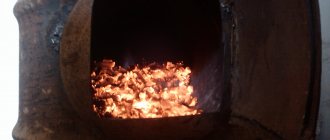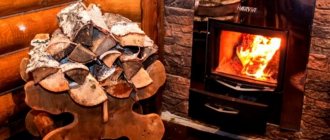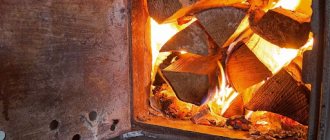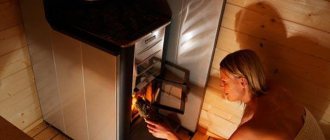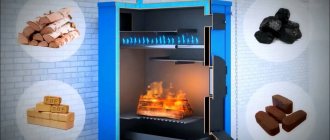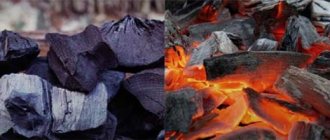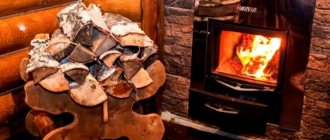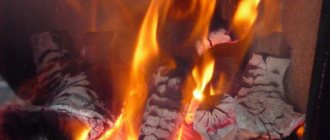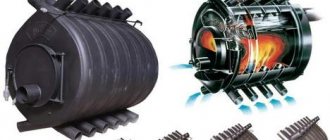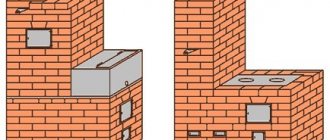Now manual labor has been replaced by various types of equipment that simplify work, regardless of its volume. And yet, what is better for heating stoves?
Humanity knows many different types of firewood. Traditionally, everything that can burn and is easily prepared is used, be it peat briquettes or dried cattle manure. Let's skip exotic types of firewood and list only the main ones.
Among the hardwoods, the most famous are birch, alder, aspen and oak. You can also add linden, poplar, maple, ash, elm, cherry, apple, pear, willow and walnut firewood.
Among coniferous species, spruce and pine are popular. But you can also find fir, cedar and larch firewood. Juniper and yew trees are more likely to be considered exotic conifers.
The wood described has different densities, therefore different weights, as well as resin content. The combustion time and the energy released depend on the first parameter. The higher the density of the wood, the longer it will smolder. The same rule applies to the part of the trunk from which the logs are prepared. Closer to the surface of the earth, the wood is denser and more difficult to split. Woodworkers know this property, which is why they consider this part of the trunk to be the best.
Such trees are suitable for making kindling chips because they do not require long-term ignition. At the same time, the resin smokes more during the combustion process, which causes rapid clogging of the chimney.
In reality, this conclusion is not entirely clear-cut. With the correct selection of the stove design and the best combustion mode, you can avoid the appearance of too much soot. Residents of taiga zones use exactly this kind of firewood and have never complained about this problem.
Depending on its density, wood can be divided into three main groups:
- Soft : pine, cedar, spruce, fir, aspen, alder and linden.
- Medium hard : birch, cherry, plum, elm, juniper.
- Hard : oak, hornbeam, maple, apple, pear, ash.
Below is a table of the relative densities of different wood species. The unit used is the density of one cubic meter of oak.
Based on the table, we can conclude that spruce is 1.5 times larger in volume compared to oak. In other words, a ton of spruce wood will take up 1.5 times the volume of oak wood.
What kind of firewood is best for lighting stoves?
It is necessary to take into account that different tree species have almost the same ability to generate heat per unit weight. At the same time, dense wood will have more heat per unit of volume. Thus, a birch log emits 20-30% more heat than a pine log.
The calorific value of wood is inversely proportional to humidity: the wetter the wood, the less heat it emits. The optimal humidity is considered to be 20-25%. The rate of freshly cut firewood is 50%. Consequently, dry logs provide 3 times more heat than wet logs.
This dependence allows us to draw the only correct conclusion: the timber must be kept dry. The ideal option is to dry it outside for a year. In this case, the firewood must be covered from precipitation or stored in a ventilated woodshed. Such logs will be most effective when burning.
Firewood or coal: which option is better?
Coal is perfect for heating boilers that are installed in a separate room or building. It is not recommended to burn this substance in a stove mounted in a living room, since coal burns for a long time and almost never burns completely. For this reason, the chimney should not be left closed to prevent carbon monoxide from entering the room. In this case, the firewood will quickly decay, producing a sufficient amount of heat. The logs burn entirely, which means you can safely close the valve without fear for your health or heat leakage through the chimney.
Ignition of coal without wood and special means is quite a difficult task. For this reason, everyone who uses such fuel is forced to purchase firewood in order to light the stove with it. Dust from coal is harmful to health, so when throwing fuel into the stove, you need to try to prevent these particles from rising into the air and dirtying everything around. Logs, on the contrary, have virtually no dirt or foreign impurities, and therefore are safer.
How to make a simple potbelly stove
For this you can use:
- Milk can with a capacity of forty liters.
- Metal box.
- An old gas water heater.
- Any metal flask of suitable size.
The procedure for making a furnace is as follows:
- A small, sickle-shaped slot is punched in the workpiece with a chisel for the blower.
Tip: If you use a milk can as a blank, the slot should be located below its neck.
- A curved pipe is inserted into the bottom of the can.
- The chimney is mounted on the pipe.
- A serpentine grate is made of steel wire six millimeters in diameter and installed inside a homemade stove through the neck.
- The grate is placed inside the homemade stove through the neck.
- The wire is stretched to ensure the most efficient combustion of the fuel, which is determined experimentally.
- Support rings made of half-inch steel pipes are installed on the sides of the potbelly stove, and legs are welded to the bottom.
- To reduce fuel consumption and increase the cooling time of the furnace, it is lined with bricks.
Is it worth heating with peat?
Peat is briquetted because it has a large amount of moisture before drying, and after this procedure it crumbles. Thanks to compaction, this problem is eliminated, however, this cannot cause a decrease in the formation of ash in large quantities during the combustion process. This disadvantage is significant when using peat. Cleaning and maintaining the stove are considered labor-intensive processes. When burning with this flammable substance, such a task becomes much more complicated, because a constant procedure for removing ash in the grate and ash pan is required, during which these harmful particles tend to scatter throughout the room.
Types of coal. Pros and cons of use
Certain types of solid fuels are transformations of the same organic material. For example, peat is formed primarily from dead plant matter in swamps. It is then coalified and converted into brown coal. At the next step - into coal.
The disadvantages of peat and brown coal are a large amount of upper moisture. If you dry them perfectly, they will crumble. This can be eliminated by pressing peat into briquettes. However, when burned, this fuel produces a lot of ash. This makes maintaining the stove difficult: you regularly need to clean the grates and ash pan, but even this is made difficult by the fact that the ash is lightweight and is sprayed around the room.
Peat in briquettes is compressed with sawdust, which makes it higher quality, convenient for storage and use. Brown coal is not beneficial for the combustion chamber of a furnace, which is why it is almost never used. In addition, it has a low calorific value (3000±500 kcal/kg) and, based on this, efficiency.
What can you use to heat a stove besides firewood? We are considering peat and coal.
The source of heat in a house where it is not possible to install gas equipment is a stove. Its action is based on the selection of natural heat that is released when a certain fuel is burned. There are several types of furnaces, which may differ in their external characteristics and internal technical structure. External parameters are formed based on the requirements of the room dimensions. Technical designs are aimed at using the generated heat as efficiently as possible for their own purposes.
It’s no secret that the efficiency of a heating system is influenced by several factors: stove design, efficiency, type of fuel. Theory shows that the heat released during the combustion of a certain mass of different types of fuel is different. Its greatest value falls on the share of firewood. But the choice of fuel depends not only on this; availability or cost makes a significant contribution to the decision on methods of generating heat. In this article we will try to find out what else can be used to heat the stove, besides ordinary firewood.
Often you have to decide what to heat the stove with besides wood. We have to abandon this excellent type of fuel for some completely objective reasons. Alternatively, peat and coal briquettes can be considered. Despite the fact that their nature of origin is the same, their properties and calorific value are different.
In order for fuel to be used directly, it often has to be pre-treated, dried, crushed, or chopped. Peat contains a lot of water inside, so it needs to be dried. But when dried, it crumbles and becomes not so much unusable as inconvenient to use. Therefore, it is pressed with the addition of sawdust into special briquettes.
The main parameter for each type of fuel is its specific heat of combustion. It shows how much useful energy can be obtained if a fixed amount of fuel is completely burned.
For peat in various variants, this value does not exceed 17 MJ. However, we cannot evaluate some physical quantities by their absolute value, so for comparison we present a fragment of the table of values.
The amount of heat in MJ released by the following types of fuel:
- coal - 27.00;
- brown coal - 12.98;
- anthracite coal - 28.05;
- peat - 12.10;
- peat in briquettes - 17.58;
- peat in the form of crumbs - 10, 84.
Coal is of natural, not man-made origin. In some regions of Russia, coal is mined, which is enough not only to supply the domestic market, but also for sale abroad.
But coal is divided into several types, which differ in the age of its formation. It is not difficult to guess that higher quality rocks differ in the duration of their occurrence in the layers. There are three types of coal classification, although the same grades are involved in each.
- Classification by formation time. In this division, four types of coal are distinguished: lignite, brown and hard coal, and anthracite coal. These breeds are listed in order of increasing age. They also differ in physical properties. Lignite is presented in the form of crumbs, since it is not able to hold its shape. Brown coal is also not very durable, but it can already be used in home stoves. Although its calorific value is far from its analogues. Hard coal is the most common and accessible type, and anthracite is considered the highest quality rock.
- Classification by humidity and content of volatile compounds. In this gradation, known rocks follow the same sequence. Their humidity decreases from 40% to 5%. A similar picture emerges with volatile substances. In this division, anthracite occupies an advantageous position.
- Classification by calorific value. We had to introduce the calorific value parameters earlier, so it makes no sense to duplicate the indicators. It should only be emphasized that this classification is decisive when choosing fuel for a home stove.
Combustion chamber of a coal furnace
Hard coal has better parameters than brown coal. Its calorific value is 6000±500 kcal/kg. Various varieties are distinguished by the degree of ash content and the amount of volatile substances:
- Coal (low ash, low in volatile substances).
- Gas (low ash, rich in volatile substances).
- Shale (forms a lot of ash, has a lot of moisture).
For use in home stoves, the most convenient type of coal is hard coal. It stores well and does not spontaneously combust. It is enough to simply pour it in the barn on the floor or in drawers. But firewood is used to ignite it, since it takes a long time to light up on its own. It is necessary to say something about the design of the combustion chamber. It must be designed to use this type of fuel. Its device is distinguished by an additional channel for supplying secondary air. Also, its role can be played by a blower or a half-open flap of the combustion chamber.
Features of furnaces using coal
The vast majority of real stove models that we remember from our grandparents were adapted to use wood and coal. This averaging of the design was carried out on purpose, because it was difficult to predict what would have to be used to heat the stove in each specific season. However, if you take a detailed approach to the construction of the furnace, then these options should differ.
The temperature inside the firebox when burning coal is much higher than when burning wood. This leads to the fact that the walls of the metal firebox are strengthened using thicker sheets. The volume of the firebox increases due to the lower location of the grate. The ash pit is built to be larger in volume, since the amount of ash when using coal is much greater than that of firewood.
Coal is excellent, wood is better
Wood is considered the optimal solid fuel for stoves. It has good parameters for energy-saving heat supply:
- ash content up to 1%,
- yield of flammable substances up to 85%,
- absence of sulfur in the composition, which destroys the furnace inside,
- calorific value 4500 kcal/kg.
Hard woods are difficult to split, but they generate high heat. Plus, they burn for a long time, organizing burning coals with good heat transfer. The working time of the combustion chamber on one fill is longer than that of firebrands made from soft varieties of trees. Solids include:
- hornbeam, oak, yew, beech, ash, hazel.
Secrets of lighting a stove
Many people tend to mistakenly evaluate fuel by the ease of its ignition. It will not be possible to light coal without firewood; in addition, the ignition process itself must be carried out correctly. This contributes to a long service life of the stove.
The stove must be inspected externally every time you intend to light it. Substances or objects that are easily flammable and were accidentally placed nearby are first removed to a sufficient distance. Before kindling, the chamber and ash pan must be cleaned, removing unburned food. To prevent small particles of ash from flying around the room, it is recommended to pour a little water into the ash pan.
Household waste containing plastic or bitumen cannot be used for kindling, as they cause the formation of large amounts of soot in the chimney. The firebox door and the ash pan should not be open in pairs. This rule is useful, since when kindling you have to adjust the draft.
Coal is usually stored indoors, but moisture may not be excluded. In this case, it must first be dried. When wet coal is burned, all the water in the form of steam goes up the chimney. A large amount of soot settles on the wet surfaces of the pipe walls.
Crumpled old newspapers are placed on the grate. Small wood chips can be placed on top of them. Wood logs are stacked in a hut or a well, depending on your habits. After this, we light the stove by closing the firebox door and opening the ash pan.
When the firewood begins to burn out and the first hot firebrands form, you can add a portion of small coal, after which larger pieces are gradually added. When burning coal, you should close the chimney damper, this will save heat. But remember that when the damper is closed, there is a high probability of filling the room with carbon monoxide. Watch the flame, a blue tint indicates that it’s time to open the damper.
What kind of firewood is best for heating a stove, tips for choosing the type of wood
It is a priori pleasant to see a live fire in your stove; it creates a cozy and comfortable atmosphere throughout the whole house, but do not forget that its main task is to heat the room. Efficient operation of the stove will allow you to warm up the space of the house at any time of the year and heat the bathhouse.
It is desirable that lighting the stove does not take much time, and the heat from it, on the contrary, lingers for a long time. This can be done by choosing the right fuel, in particular firewood. In this article we will talk about what kind of firewood is best to heat the stove, we will focus on different types of wood, we will study deciduous and coniferous options and specific types of wood.
Characteristics of firewood
It is not always appropriate to compare heating a house with a stove and electricity or gas, since the stove additionally creates an atmosphere of comfort and unique family coziness. How pleasant it is to hear the soft crackling of firewood in the hearth in the silence of the doom, to feel the warmth emanating from it. Even in our time, these unique feelings are so pleasant to people that a high-quality stove or a good fireplace is built in almost every private home.
However, in order to effectively use the capabilities of the stove, you should understand firewood. It turns out that not all tree species are equally good for burning; there are many nuances that significantly complicate the choice of firewood for the stove.
For example, for burning in a fireplace, it is advisable to find wood that, when burned, emits a pleasant aroma, but does not emit a large amount of resin, soot, or soot. Resins in wood contribute to increased smoke output, as well as explosive cracking of logs with the release of large coals. Such emissions will be unsafe for an open fireplace, so coniferous wood is not used in them.
Firewood for the stove is selected based on heat transfer; its main criteria are the intensity and duration of combustion. It is desirable that the wood burns with less smoke and leaves behind a minimum of ash.
If we consider the optimal firewood for use in a stove, then it should have the following functionality:
- First of all, heat transfer is the maximum possible for wood.
- The flammability of the wood must also be excellent, so that lighting a fireplace is not difficult.
- When burned, firewood should not emit a lot of smoke and leave behind a small amount of ash.
To achieve such characteristics, it is important not only to choose the right type of wood, but also to properly dry the harvested timber and ensure its normal storage. Freshly cut wood is not used in kilns; to prepare it, it should be dried for some time, getting rid of excess moisture. Wet wood burns weakly and produces a large amount of smoke.
There is even a method for determining whether firewood is dry enough for use in fireplaces or stoves. You should hit one log against another and listen to the sound. If it is sonorous, then it is quite possible to use such logs for heating the hearth.
It is believed that the best firewood for fireplaces and stoves is obtained if logging is carried out in the winter. At this time, the trees are in a certain preserved state, as a result of which sap flow practically does not work in them. The worst thing is if the firewood is collected in the spring or summer, when the wood contains a large amount of moisture, such wood will dry out for a very long time.
If we consider tree species, then it is best to choose deciduous options, since they have a fairly dense fiber structure. Such wood is capable of generating large amounts of heat for a long time. Most often, firewood is prepared from the following hardwoods: oak, birch, linden, alder, ash, aspen. Even fruit trees can be a good source of heat. In addition, the fragrant wood is perfect for use in a smokehouse or open fireplace.
Coniferous wood also burns well, but since they contain a large amount of resin, they emit a lot of smoke and soot when burning. The needles burn quite quickly, but produce mediocre heat, so for use in a stove at home it is better not to particularly consider this option, but to save the logs for the bath.
Firewood from deciduous trees
In order to optimally choose firewood for heating the stove, based on specific needs, let’s first consider the most popular species of deciduous trees for use in heating the house.
Oak firewood. Experts have long noted oak firewood as wood with almost maximum heat transfer (oak is inferior to ash). At the same time, oak burns for a long time, which allows you to significantly reduce the consumption of logs. These characteristics of oak are explained by its dense, hard structure. Naturally, oak firewood is more expensive than all others, but savings can be seen in the ability to heat a room with less fuel.
It is believed that middle-aged oak should be used for harvesting, since it is at this time that its characteristics are maximum. When burned, such wood emits intense heat, as well as a very pleasant, characteristic aroma of the forest. Oak firewood is actively used to fire open fireplaces; they allow you to create a pleasant atmosphere in the room, filled with the healing aromas of the forest.
Interesting fact: true Italian pizza is baked in an oven using exclusively oak wood. Italy is not rich in this type of firewood, so oak wood is very valuable in this country.
Ash has similar characteristics, as do fruit trees such as apple or pear, but they must also be harvested at a certain average age.
Birch firewood. The next very popular wood we will look at is birch. Birch firewood is actively used for stoves in bathhouses, as it not only provides excellent heat and aroma, but is also endowed with disinfectant properties. In addition to this, a bathhouse heated with birch wood is full of healing properties; it perfectly helps to cope with colds and chronic respiratory problems.
However, there are also nuances when harvesting birch. It has long been proven that firewood from this tree loses its main properties after 2-3 years of storage. This can be determined by the appearance of the log; it becomes rotten. You should not expect intense heat from such firewood, and the classic aroma completely disappears from them.
Birch wood and its bark contain a large amount of tar. You can observe it when the bark burns, when it begins to emit black clouds of smoke. Tar is a carbon compound, so it can ignite instantly and burn with great intensity. Moreover, after combustion there is practically no ash left from the birch. Birch bark and logs are often used to light stoves, since such wood burns even when damp.
If we compare birch firewood and pine or alder wood, then in terms of heat transfer they are 25-30% higher.
Alder firewood. Alder wood can be immediately recognized by its characteristic color, which can be orange, red, bluish, or ocher. Different colors indicate a specific breed of alder, and at the moment there are about 20-25 of them. In ancient times, alder firewood was called “royal” firewood, since it was used for heating the houses of the nobility for many centuries.
Alder firewood has a remarkable property: it dries independently under normal storage conditions. This property is most often characteristic of alder, which grew far from rivers, lakes, and in soil with a small amount of moisture.
Another remarkable property of alder is its unique aroma, which the wood retains for 2-3 years of storage. After this time, the aroma during combustion will be negligible, but the level of heat transfer will not change. In ancient times, alder was actively used to fire black saunas, since when burned it produces virtually no smoke. It is believed that alder wood helps clear soot from the chimney, releasing a certain type of vapor during combustion.
Possessing a unique aroma, alder is actively used in smoking meat and fish; it is not without reason that when harvesting alder, sawdust is collected for future use.
Ash firewood. Ash wood is rarely found on sale and is expensive, since in terms of heat transfer this type of wood is comparable to oak, and even slightly superior. Harvesting ash involves certain problems; due to its hard structure, it is very difficult to saw into pieces.
Note that ash burns well even when damp, it does not spark and produces an even flame. If you need to heat the stove with raw wood, use ash or birch. If you find such firewood at an affordable price, be sure to purchase it.
Firewood from linden. To quickly light stoves, experienced owners can use linden wood. The wood of this tree is quite difficult to set in fire, but then burns very intensely, releasing a large amount of heat, which contributes to the rapid heating of the stove. This property is perfect for firewood for a bathhouse, the main task of which is to prepare excellent conditions for relaxation in a short time.
In addition, like birch firewood, linden has healing properties; it helps with colds and respiratory diseases. It is believed that if you add a few spoons of honey to the linden firebox, the resulting combined aroma and steam will heal old, poorly healing wounds.
Linden firewood does not lose its properties for about two years after cutting down the tree. In the third year, the healing and thermal characteristics of the wood gradually fade away.
Firewood from aspen. Aspen firewood is similar in functionality to alder, at least it also effectively fights soot in the chimney. When burned, aspen produces virtually no smoke and produces characteristic steam. This steam has a beneficial effect on soot, which softens and moves away from the walls of the chimney. When aspen wood burns inside the stove, you can hear soot falling into the firebox or ash pan.
At the same time, the heat transfer from burning aspen is small and is unlikely to be enough to fully heat the room. Therefore, such firewood is used exclusively for preventive purposes. Aspen firewood for the stove will be extremely necessary if it was previously heated with coniferous wood.
Firewood from willow and poplar. Poplar and willow firewood have one drawback. They are rarely used to fire stoves because they burn out very quickly. To heat a room with such firewood, you need to use a lot of it, so even a low, attractive price is not able to concentrate attention on it.
Experts have long classified willow and poplar firewood as low-grade, which is used in rare cases when a normal type of wood is not available.
Firewood from fruit trees. You rarely see firewood from fruit trees, but in terms of their characteristics they are quite good. Such wood in a stove will easily warm a house, but most often this wood is used for fireplaces or smokehouses due to its exclusivity. It is rare to find such firewood, because most often they appear after cutting down old orchards.
Firewood from coniferous trees
Coniferous wood contains a large amount of resin, which promotes rapid and intense combustion with a large release of smoke and soot. Regular use of pine firewood contributes to the formation of thick layers of soot on the walls of the chimney.
That is why coniferous wood is practically not in demand for heating houses; it is used to kindle stoves in bathhouses. The melted hearth of pine needles fills the steam room with a classic spruce aroma, which calms the nerves and has a beneficial effect on the respiratory system. The forest pine aroma appears thanks to the essential oils present in the pine needles. When burned, spruce and pine firewood produces a characteristic crackling noise that many people enjoy.
Note that burning coniferous wood is difficult to extinguish, and the embers flying out of it make this wood the most fire hazardous. Therefore, it is best to heat a closed stove or fireplace with pine or spruce firewood.
After analyzing all existing types of wood, you can easily find the best firewood for heating stoves in your home and bathhouse. Use different tree species, find the optimal solution for a specific situation. Enjoy the pleasant aroma, warmth and comfort that burning wood firewood gives you.
The best of the best: fruity, birch and linden
This list is also supplemented by fruit trees: pear, apple tree.
They emit a pleasant aroma and burn well, but it is difficult to make kindling with any hard logs. Birch and linden are considered the best for heating a stove. Birch has a low amount of moisture even in its raw form. Logs can be placed in the firebox without drying, they will still give off great heat and will smolder for a long time. Linden is valued for its healing properties. If you heat the stove with linden wood, you will have a healing microclimate in your house or bathhouse. Linden burns slowly, with good heat transfer. Thus, the best varieties are hardwoods, and of these, birch and linden.
Softwood
Soft varieties of wood melt quickly, but require drying to a residual moisture of 20% and proper storage. These include coniferous varieties. Disadvantages: large amount of resins, high sparkle (with an open firebox the fire hazard increases). As a rule, common types are used: pine and spruce. They are easy to chop and saw, the cost of purchasing this firewood is quite low.
